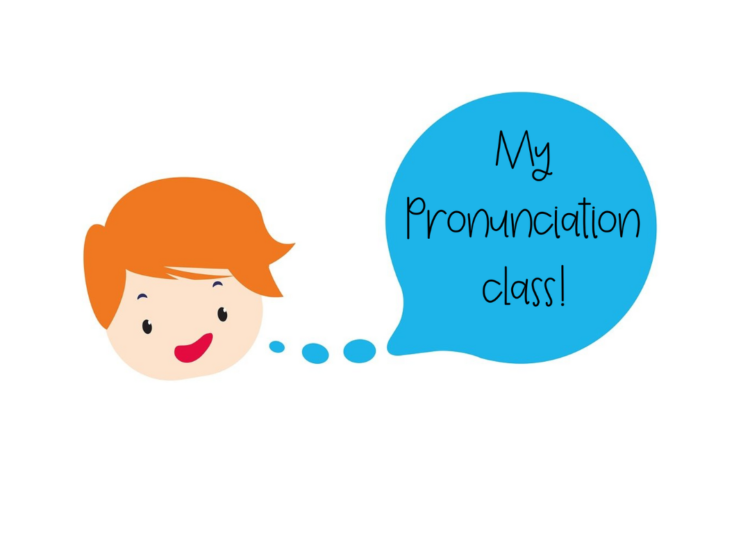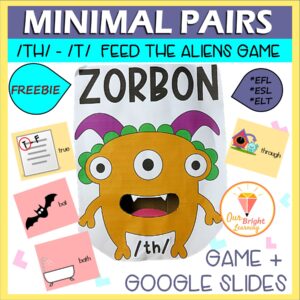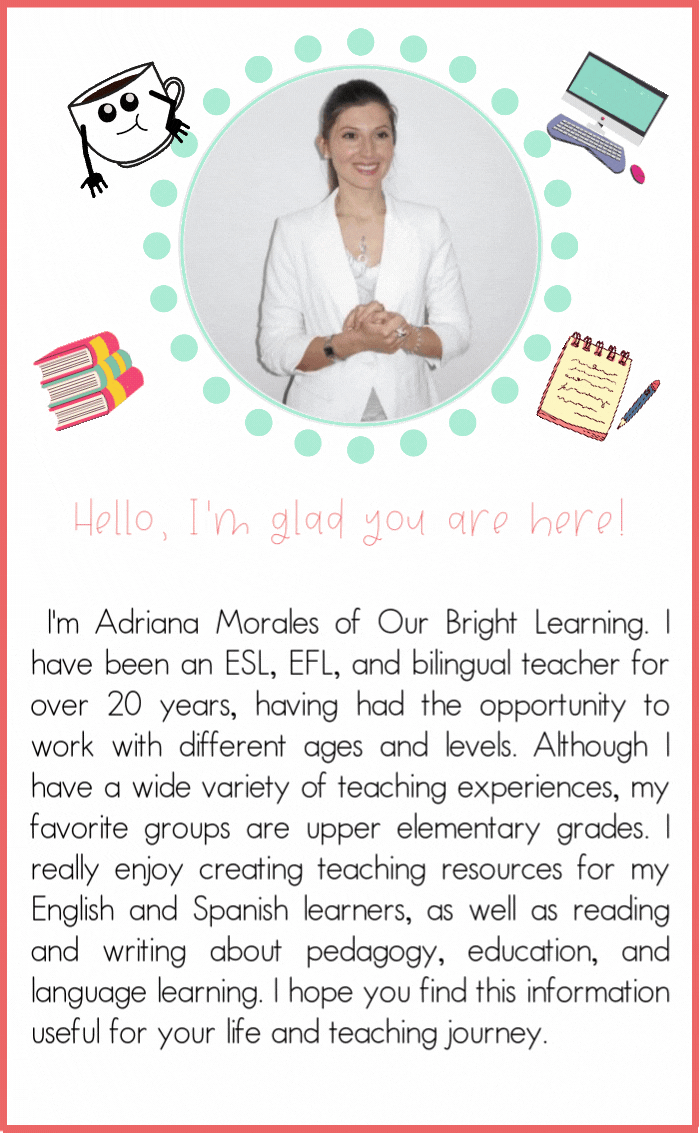How to Plan a Pronunciation Lesson for Young ESL and EFL Students
Photos: https://pixabay.com/
Fonts: a perfect blend: https://www.teacherspayteachers.com/Store/A-Perfect-Blend
Gifs: https://giphy.com/
Last week I read an interesting text about pronunciation instruction in the second and foreign language classrooms. In this article, the authors clearly stated how important it is to teach students pronunciation in a direct way. Although I have had the opportunity to teach phonics in a bilingual school, I have also found it interesting to write a lesson plan following the steps proposed in the article.
General Lesson Layout
It is relevant to remind you that these authors also provide some tips on realistic goals creation. If you want to read these tips, visit my Instagram account.
Well, let’s start! Celce -Murcia et al. (2010) suggest five planning stages:
-
Description and Analysis.
-
Listening Discrimination.
-
Controlled Practice.
-
Guided Practice.
-
Communicative Practice.
Let me explain these stages with the following lesson plan:
LESSON PLAN

Group: 3rd Grade (8- and 9-year-olds)
Target Sound: TH and T sounds – /θ/ and /t/
Topic: The Aliens’ Diet
Objectives:
-
Distinguish between the /th/ and /t/ sounds using minimal pairs and other exercises.
-
Practice the correct pronunciation of /th/ and /t/ sounds through activities like songs.
-
Enhance the pronunciation of the sounds through role-playing exercises to practice using the sounds in context.
-
Be able to produce the sounds to the best of their abilities while producing language in a more spontaneous way.Looking to learn more about setting goals for teaching pronunciation? Check out our latest Instagram post!

-
10’ Warm-Up: I made up the following story to contextualize the lesson:
Story:

Once upon a time, there were two cute and friendly aliens travelling around the galaxy; their names were Zorbon and Glarvon. They had been travelling for months and they were extremely hungry, so they decided to stop on the Earth. They had never tasted human food before so they didn’t know what to eat.
Zorbon could only eat foods containing vitamin /th/ and Glarvon could only eat foods with /t/ minerals. We must help them find the best foods for them, but first we need to learn how to identify these types of nutrients.
The authors propose a series of steps to keep in mind when designing our lessons. Here you have a short explanation of each one of them and the way I applied them to this lesson.
15’ STEP 1. Description and Analysis:
The authors suggest to introduce the sounds with charts and diagrams that allow learners to see how the sound is produced. In many adult ESL and EFL classrooms, the teachers usually use those graphics to show the point and form of articulation and a real conversation.
Although many teachers do this with older learners, when working with children this must be much more fun and tangible. That’s why I decided to include a song and a fun game in which students could notice both the point and manner of articulation of the two target sounds.
For the /t/ sound I chose the song : Phonics Song | Letter Tt | Phonics sounds of Alphabet | Nursery Rhymes for Kids at the Youtube channel Little Fox: https://www.youtube.com/watch?v=FPdzx06Ur_4

On the other side, I used “Starfall” which is one of my favorite phonics websites to introduce the /th/ sound. Check it out in the following link: https://www.starfall.com/h/ltr-lv-e/th-skill/?sn=ltr-classic
As I mentioned before, I also wanted to provide multiple examples so I took some of these examples to challenge my learners. I divided the class in four small groups and asked my learners to pronounce one of the words (the ones found in the song and game) together; the groups with the correct or the best pronunciation were the winners. I gave them points for their participation. After, I challenged them to participate individually, so that they had an individual practice moment as well.
25’ STEP 2. Discrimination Stage:
In this stage, we are supposed to promote the identification and discrimination of the sounds. Children are able to identify a sound when they can point at, or underline the syllables or letters involved in the sound. Besides this, they must be able to discriminate a sound from a set of similar words, which means that they are able to find the existing differences.
Knowing this, I decided to propose two different activities. The first one is focused on identification and the other one on discrimination.
The first one was a game. I divided my leaners in four groups again, and I created a list of sentences using some of the words studied with the video and game. I challenged my learners to listen to me and try to identify the sounds. If they heard the /t/ sound, they were supposed to stand up and clap once, if they heard the /th/ sound, they were to remain seated and clap twice. I uttered the sentences extremely slowly so that they could easily identify the sounds and react.

My list of sentences was the following:
-
When I was a little girl, I played with my top and my turtle.
-
I take a taxi to come to
-
My sister and I always play with our thumb
-
My students always brush their teeth while riding a
After saying the sentences two or three times, I displayed them on the screen.
The second activity was a /th/ – /t/ minimal pairs feed the aliens contest in which students had to discriminate each sound and feed the two aliens with the appropriate food. Zorbon can only eat foods containing /th/ vitamins, while Glarvon can only eat foods containing the /t/ minerals.
If you are interested in this minimal pairs game click on the image below.
20’ STEP 3. Controlled Practice:
During this stage, the teacher must provide an activity in which students can focus more on the form than any other aspect involved in the communication. So, I decided to ask them to use a dialogue containing the target sounds. After modeling the correct pronunciation with one of my students, I asked my pupils to practice it several times with different classmates. They had to focus on the pronunciation of the highlighted words.
In order to promote the interaction with different classmates, I used the “run, jump, crawl” grouping technique. Click here if you are interested in learning more about grouping techniques.
While my students were performing their conversations, I wrote down their mistakes and supported them right after each conversation had finished. They interacted with three different partners.
CONVERSATION

Zorbon: Hey, did you know that plants on the Earth have different parts?
Glarvon: Really? Like what?
Zorbon: Look! Some plants have thorns to protect themselves. I think we can’t eat them! (Zorbon points at some of the plants)
Glarvon: That’s true! I like thorns. They are cool!
Zorbon: Haha, yeah! But we learned that not all plants on Earth have thorns.
Glarvon: Really? I thought all plants had thorns.
Zorbon: Nope, that’s not true. It’s important to learn about them first. We need to find the ones we can eat.
Glarvon: Yeah, you’re right. Our alien teacher, Mrs. Zylaxx, taught us so much about Earth plants last year. Do you remember?
Zorbon: Yeah, she’s the best teacher!
15’ STEP 4. Guided Practice:
The objective of this stage is to create a bridge between the mere practice of the target sounds and the other elements like grammar, meaning, and efficient communication. To achieve this, I asked my pupils to work in pairs and interview their classmates. The topic of the interview was Aliens. Each student must ask two questions. To make pairs, we used the same grouping technique used before.
-
Do you think that aliens play with their thumbs? (Yes/No, they play/don’t play with their thumbs.)
-
Do you think that aliens visit the Earth? (Yes/No, I think/don’t think that aliens visit the Earth.)
-
Do you think that aliens have taxis on their planet? (Yes/No, aliens have/don’t have taxis.)
4. Do you think aliens eat plants with thorns? (Yes/No, aliens eat/don’t eat plants with thorns.)
After doing the interview, I asked my learners to tell me about their classmates. To do that, I asked them to use the following prompts:
____________ thinks that aliens play/don’t play with ___________.
____________ thinks that aliens visit/don’t visit the Earth.
____________ thinks that aliens have/don’t have taxis on their planet.
____________ thinks that aliens eat/don’t eat plants with thorns.
20’ STEP 5. Communicative Practice:
This is the last part of our lesson and we must provide an activity that promotes the balance between the form and meaning. The writers suggest role-plays, debates, interviews, simulations, and drama scenes. At first, I was thinking about something they could perform one hundred percent free, but then I realized my students are still very young and they needed a visual support to be able to produce higher quantity and quality output, so I ended up creating a set of images and words they would use to create their “original” conversation in pairs. The images and words displayed on the screen will slightly prompt the students’ ideas.

These pictures represent two scenes; the first is the one in which the aliens are landing on the Earth because they are extremely hungry; the second shows the two characters on the Earth trying and eating some of the fruits found here. During the last step it was necessary to help some pairs more than others because of variables such as their experience with the language, confidence, and literacy level.
Download the Google Dlides by clicking the next link:
After having developed and applied this lesson plan, it was evident there are advantages and disadvantages with this type of instruction. A remarkable advantage is that the use of minimal pairs truly helps learners not only with their pronunciation, but also with some other abilities such as the acquisition of new vocabulary, the improvement of their listening, and accent. However, this type of lesson plan might also be demotivating or a complete failure if not adapted to the age, level, and particularities of each group of students. It is necessary to consciously evaluate how far it is possible to apply the theory and steps developed by the authors, and to adapt them as I did in the last step.









Discussion about this post